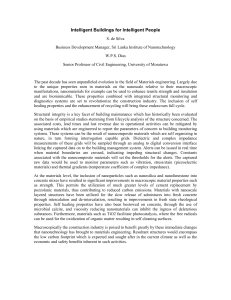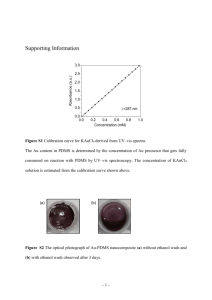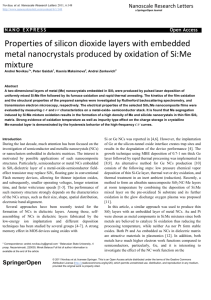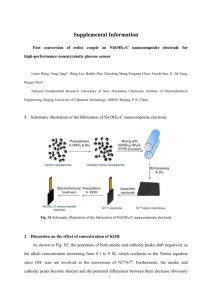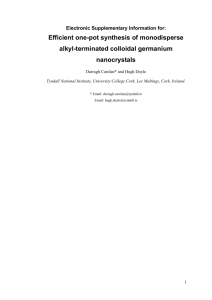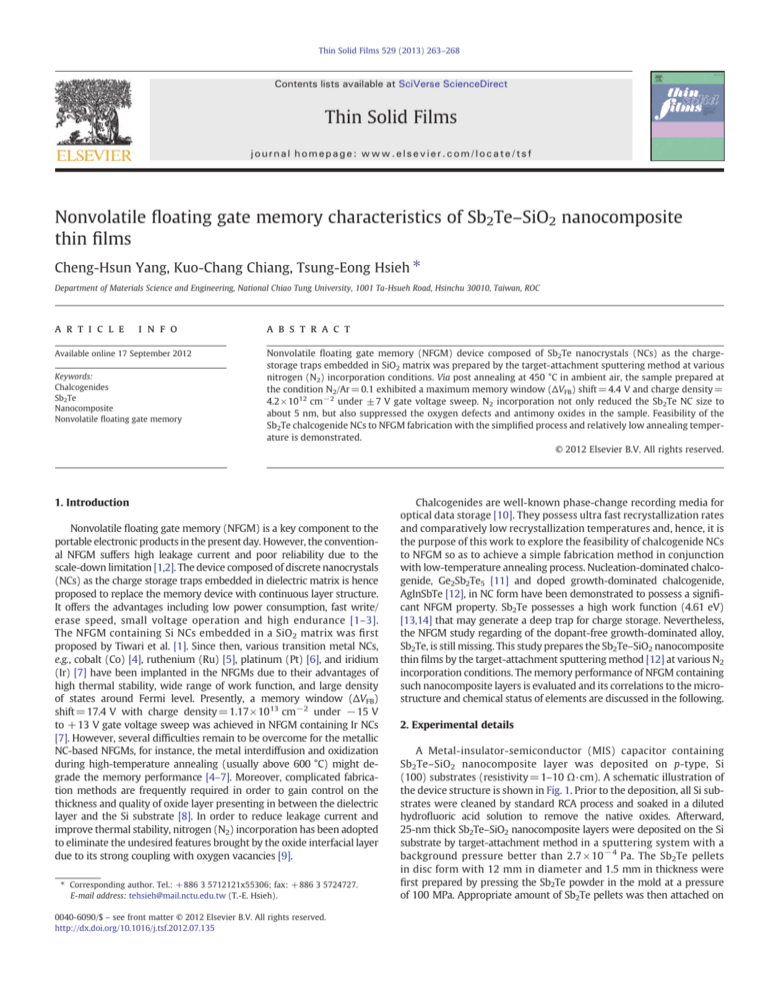
Thin Solid Films 529 (2013) 263–268
Contents lists available at SciVerse ScienceDirect
Thin Solid Films
journal homepage: www.elsevier.com/locate/tsf
Nonvolatile floating gate memory characteristics of Sb2Te–SiO2 nanocomposite
thin films
Cheng-Hsun Yang, Kuo-Chang Chiang, Tsung-Eong Hsieh ⁎
Department of Materials Science and Engineering, National Chiao Tung University, 1001 Ta-Hsueh Road, Hsinchu 30010, Taiwan, ROC
a r t i c l e
i n f o
Available online 17 September 2012
Keywords:
Chalcogenides
Sb2Te
Nanocomposite
Nonvolatile floating gate memory
a b s t r a c t
Nonvolatile floating gate memory (NFGM) device composed of Sb2Te nanocrystals (NCs) as the chargestorage traps embedded in SiO2 matrix was prepared by the target-attachment sputtering method at various
nitrogen (N2) incorporation conditions. Via post annealing at 450 °C in ambient air, the sample prepared at
the condition N2/Ar = 0.1 exhibited a maximum memory window (ΔVFB) shift = 4.4 V and charge density =
4.2 × 10 12 cm −2 under ± 7 V gate voltage sweep. N2 incorporation not only reduced the Sb2Te NC size to
about 5 nm, but also suppressed the oxygen defects and antimony oxides in the sample. Feasibility of the
Sb2Te chalcogenide NCs to NFGM fabrication with the simplified process and relatively low annealing temperature is demonstrated.
© 2012 Elsevier B.V. All rights reserved.
1. Introduction
Nonvolatile floating gate memory (NFGM) is a key component to the
portable electronic products in the present day. However, the conventional NFGM suffers high leakage current and poor reliability due to the
scale-down limitation [1,2]. The device composed of discrete nanocrystals
(NCs) as the charge storage traps embedded in dielectric matrix is hence
proposed to replace the memory device with continuous layer structure.
It offers the advantages including low power consumption, fast write/
erase speed, small voltage operation and high endurance [1–3].
The NFGM containing Si NCs embedded in a SiO2 matrix was first
proposed by Tiwari et al. [1]. Since then, various transition metal NCs,
e.g., cobalt (Co) [4], ruthenium (Ru) [5], platinum (Pt) [6], and iridium
(Ir) [7] have been implanted in the NFGMs due to their advantages of
high thermal stability, wide range of work function, and large density
of states around Fermi level. Presently, a memory window (ΔVFB)
shift=17.4 V with charge density=1.17×10 13 cm−2 under −15 V
to +13 V gate voltage sweep was achieved in NFGM containing Ir NCs
[7]. However, several difficulties remain to be overcome for the metallic
NC-based NFGMs, for instance, the metal interdiffusion and oxidization
during high-temperature annealing (usually above 600 °C) might degrade the memory performance [4–7]. Moreover, complicated fabrication methods are frequently required in order to gain control on the
thickness and quality of oxide layer presenting in between the dielectric
layer and the Si substrate [8]. In order to reduce leakage current and
improve thermal stability, nitrogen (N2) incorporation has been adopted
to eliminate the undesired features brought by the oxide interfacial layer
due to its strong coupling with oxygen vacancies [9].
⁎ Corresponding author. Tel.: +886 3 5712121x55306; fax: +886 3 5724727.
E-mail address: tehsieh@mail.nctu.edu.tw (T.-E. Hsieh).
0040-6090/$ – see front matter © 2012 Elsevier B.V. All rights reserved.
http://dx.doi.org/10.1016/j.tsf.2012.07.135
Chalcogenides are well-known phase-change recording media for
optical data storage [10]. They possess ultra fast recrystallization rates
and comparatively low recrystallization temperatures and, hence, it is
the purpose of this work to explore the feasibility of chalcogenide NCs
to NFGM so as to achieve a simple fabrication method in conjunction
with low-temperature annealing process. Nucleation-dominated chalcogenide, Ge2Sb2Te5 [11] and doped growth-dominated chalcogenide,
AgInSbTe [12], in NC form have been demonstrated to possess a significant NFGM property. Sb2Te possesses a high work function (4.61 eV)
[13,14] that may generate a deep trap for charge storage. Nevertheless,
the NFGM study regarding of the dopant-free growth-dominated alloy,
Sb2Te, is still missing. This study prepares the Sb2Te–SiO2 nanocomposite
thin films by the target-attachment sputtering method [12] at various N2
incorporation conditions. The memory performance of NFGM containing
such nanocomposite layers is evaluated and its correlations to the microstructure and chemical status of elements are discussed in the following.
2. Experimental details
A Metal-insulator-semiconductor (MIS) capacitor containing
Sb2Te–SiO2 nanocomposite layer was deposited on p-type, Si
(100) substrates (resistivity= 1–10 Ω·cm). A schematic illustration of
the device structure is shown in Fig. 1. Prior to the deposition, all Si substrates were cleaned by standard RCA process and soaked in a diluted
hydrofluoric acid solution to remove the native oxides. Afterward,
25-nm thick Sb2Te–SiO2 nanocomposite layers were deposited on the Si
substrate by target-attachment method in a sputtering system with a
background pressure better than 2.7 × 10 − 4 Pa. The Sb2Te pellets
in disc form with 12 mm in diameter and 1.5 mm in thickness were
first prepared by pressing the Sb2Te powder in the mold at a pressure
of 100 MPa. Appropriate amount of Sb2Te pellets was then attached on
264
C.-H. Yang et al. / Thin Solid Films 529 (2013) 263–268
Vg
Al electrode
Sb2Te NCs
Sb2Te-SiO2 nanocomposite layer
p-Si substrate
Fig. 1. Schematic illustration of NFGM device structure.
the 3-inch quartz target for subsequent sputtering deposition of
nanocomposite layers. Since the content of Sb2Te NCs in nanocomposite
layer is proportional to the number of Sb2Te pellets, one could thus
adjust the density of charge trapping sites in NFGM sample to achieve
the desired electrical performance. As mentioned above, complicated
methods such as atomic layer deposition were often required to prepare
the blocking oxide/NCs/tunneling oxide device structure for NC-based
NFGMs [15]. Analytical results presented in the following illustrate that
such a multilayer device structure can be achieved in the chalcogenide
NC-based nanocomposite layers prepared by the target-attachment
method. It is hence a simple and versatile thin-film deposition process
which allows us to verify the feasibility of chalcogenides to NFGM
fabrication.
In this work, the deposition was carried out without intentional
substrate heating at radio-frequency sputtering power of 80 W,
working pressure of 0.4 Pa and various Ar/N2 inlet gas flow ratios
(in the unit of sccm) of 10:0 (N00 sample), 10:1 (N10 sample) and
10:2 (N20 sample). The N00, N10 and N20 samples were deposited at
the rates of 1.9, 0.6 and 0.5 nm/min, separately, and the thickness of
the nanocomposite layers was fixed at 25 nm. N2 addition is known
to eliminate the oxygen defects and reduce the leakage current of dielectric layers [16]. Effects of N2 content on the interfacial states at the
NC/oxide interfaces and the charge trapping properties of NC-based
NFGMs have been reported previously [17]. Moreover, the studies of
phase-change media for optical discs found that the recrystallization
behaviors of chalcogenides can be modulated by N2 doping [18].
Since the effect of N2 incorporation on the chalcogenide NC-based
NFGM is not fully understood, this study hence varies the Ar/N2
inlet gas flow ratios during sputtering so as to investigate its influence
on the microstructure of Sb2Te–SiO2 nanocomposite layers and the
performance of NFGM. Subsequently, the post annealing at 450 °C
for 270 s in ambient air was performed in order to induce the recrystallization of Sb2Te phase in nanocomposite layers. Note that the
annealing condition has been optimized to achieve the best memory
performance. Finally, 300-nm thick Al electrodes with 0.2 mm in diameter were deposited by e-beam evaporation to complete the sample preparation.
The microstructures of NFGM devices were characterized by transmission electron microscopy (TEM, FEI TECNAI G2 F20 S-TWIN) with an operating voltage of 200 kV. The cross-sectional TEM (XTEM) samples were
prepared by the focused ion beam (FIB, FEI Helios 400S) technique using
the 8-keV Ga+ ion source for sample milling. An energy dispersive
spectroscopy (EDX, Link ISIS 300) attached to the TEM was adopted to
analyze the stoichiometric ratio of chalcogenide NCs. The chemical status
of the elements in nanocomposite samples was analyzed by an X-ray
photoelectron spectroscopy (XPS, PHI Quantera SXM) using monochromic Al Kα (1486.6 eV) radiation as the X-ray source. The curve fitting of
XPS profiles was achieved by using the XPS Peak 4.1 software. The spectra
were de-convoluted with a Shirley background and optimized by
allowing the 100% Gaussian with fixed full width at half maximum.
Capacitance–voltage (C–V) and charge retention properties of NFGM
devices were evaluated by a HP 4284A precision LCR meter at a frequency of 1 MHz. Current–voltage (I–V) measurement was carried out by
using an HP 4156B semiconductor parameter analyzer in conjunction
with a probe tester (SANWA, WM-365A-1). All electrical measurements
were performed in ambient air at room temperature.
3. Results and discussion
Fig. 2(a) presents the C–V characteristics of various NFGM samples
subjected to ±7 V gate voltage sweeps. It is worthy to note that the
counterclockwise hysteresis loops indicate electron trapping/detrapping
in NCs during the substrate injection [3]. The N00 sample exhibits a
negligible ΔVFB shift of 0.4 V, indicating the poor charge storage in NCs
during the memory operation. As to N10 and N20 samples, the ΔVFB shifts
of 4.41 V and 3.38 V with the corresponding charge densities of
4.21×1012 cm−2 and 3.61×1012 cm−2 were achieved. Moreover, the
significant negative shifts of C–V profiles imply the presence of positive
fixed charges, e.g., oxygen vacancies, in nanocomposite layer [19].
Though the C–V results shown in Fig. 2(a) clearly indicate that N2 incorporation enhances the charge storage capability of NCs, excessive N2
addition in fact degrades the electrical performance as revealed by the
C–V profile of N20 sample. This is ascribed to the formation of nitrides
near the substrate which would trap the charges and suppress the
Coulomb's blockage effect in the nanocomposite layer [20]. The presence
of nitride phase in the samples will be discussed in the following XPS
analysis.
Fig. 2(b) presents the current density–electrical field (J–E) characteristics of the samples deduced by the I–V measurement. At the
substrate injection case (i.e., positive bias on the top Al electrode), N10
sample apparently exhibits the lowest leakage current density of
1.28× 10−10 A/cm2 at a bias field of 8 MV/cm in comparison with the
other samples. This implies a good Coulomb's blockage effect on such
sample that the suppression of charge de-trapping from NCs to the substrate would benefit the data retention property [21]. In the case of gate
injection (i.e., negative bias on the top Al electrode), relatively high leakage currents were observed for all samples. This indicates a preference of
charge injection from NCs to the gate electrode. Lee et al. pointed out that
the asymmetric J–E behavior of memory device is resulted from the difference in energy barrier height for charge transport [22]. Fig. 2(c) presents
the schematic band diagram of NFGM samples at the substrate and gate
injection cases. Notably, the presence of the ultrathin TeO2 and SiO2 layers
in NFGM sample will be illustrated by the following TEM and XPS characterizations. In the case of substrate injection, the electrons have to tunnel
through the SiO2 layer with a relatively high barrier (Eg =9 eV) to the
nanocomposite layer so as to be trapped in Sb2Te NCs. On the other
hand, electrons tunnel from gate electrode through the TeO2 layer with
low barrier height (Eg =3.75 eV) [23] in the case of gate injection. The
low energy barrier height feature of TeO2 would result in a large tunneling
current. This also implies that the charges stored in NCs may jump back to
the gate electrode due to the low energy barrier. This consequently degrades the trapping efficiency and a high leakage current in gate injection
case.
Table 1 summarizes the charge retention characteristics of NFGM
samples. The retention was measured by a voltage stress of ± 5 V on
the top Al electrode in 10 s interval. Notably, the retention properties of the N00 sample diminished at about 10 3 s. The best retention
property was observed in N10 sample which exhibits the ΔVFB shift of
2.05 V and the charge loss of 27.8% after the test duration for 104 s.
The electrical characterizations clearly indicated that appropriate N2
incorporation improved the charge retention property of NFGM, indicating a result of imperfection remedy in the nanocomposite layer revealed by the following microstructure and composition analyses.
Electrical analyses presented above also illustrate the feasibility of
Sb2Te–SiO2 nanocomposite layer to NFGM fabrication. Via a one-step
sputtering process, the single programming-layer memory device
C.-H. Yang et al. / Thin Solid Films 529 (2013) 263–268
1.2
(a)
N
N
N
J (A/cm2)
C/Cox
0.4
00
N
10
N
20
0.6
N
10-3
10
0.8
(b)
10-1
00
1
265
20
10-5
10-7
10-9
0.2
10-11
0
-6
-4
-2
0
2
4
10-13-8
6
-6
-4
(c)
-2
0
2
4
6
8
E (MV/cm)
Gate Voltage (V)
Gate injection
Substrate injection
(+)
(-)
(-)
(+)
e¯
e¯
EC
Al
EC
Sb2Te
EV
Al
p-Si
p-Si
Sb2Te
EV
TeO2
TeO2
SiO2
SiO2
Fig. 2. (a) C–V and (b) J–E characteristics of NFGM samples. The gate voltage sweep range is ±7 V for C–V measurement. (c) Schematic energy band diagrams of NFGM samples
under substrate and gate injection processes.
with satisfactory electrical performance can be achieved. Moreover, it
effectively saves the thermal budget of the NFGM process since the utilization of chalcogenide NCs as the charge traps dramatically reduces the
temperature and time span of post annealing process in comparison
with previous studies [4–7].
XTEM images of Sb2Te–SiO2 nanocomposite layers in the N00, N10 and
N20 samples are separately presented in Fig. 3(a)–(c). It can be readily
seen that the amount of N2 incorporation affects the sizes and distribution of Sb2Te NCs in the nanocomposite layer. As shown in Fig. 3(a),
the column-like Sb2Te phase emerges in the N00 sample. Severe
overlapping of Sb2Te NCs occurred in such a sample that it not only impoverishes the charge trap sites, but also forms the leakage channel of
charges. This explains the poor C–V performance of N00 sample as
depicted in Fig. 2(a). Uniformly dispersed Sb2Te NCs with size of about
5 nm were observed in N10 sample as shown in Fig. 3(b) and (d). This illustrates that appropriate N2 incorporation may result in the discrete NCs
and hence suppresses the lateral charge loss [21]. Moreover, it increases
Table 1
Summary of charge retention characteristics of NFGM samples.
Sample
designation
ΔVFB shift
(after 104 s retention)
Charge loss
(at ±5 V)
N00a
N10
N20
–
2.05 V
2.03 V
–
27.8%
28.9%
a
Memory property diminished in less than 103 s.
the number of NCs and, hence, the number of charge trapping sites in the
nanocomposite layer. A satisfactory memory performance was thus
achieved in the N10 sample. As to N20 sample, it contains ultra small
Sb2Te NCs with size of about 3–4 nm as shown in Fig. 3(c). Though the
number of NCs seemed to increase with increasing N2 incorporation,
TEM characterization revealed rather weak and vague image contrast
for NCs in N20 sample. This implies a suppression of crystallinity of chalcogenide phase due to excessive N2 addition. The studies relating
phase-change media for optical discs reported that the N2 doping results
in the formation of nitride phases which may alter the recrystallization
behaviors of chalcogenides [18]. As a matter of fact, the following XPS
analysis reveals the presence of antimony nitride (Sb3N4) in the N2-incorporated samples. The NCs with ultra small size and poor
crystallinity hence formed in the N20 sample. Moreover, excessive N2
incorporation during sputtering is known to amplify the chemical
etching effect of the deposited layer. This also degrades the quality of
nanocomposite layer and, hence, the memory performance of N20 sample.
We note that EDX analysis performed in the TEM indicates the
stoichiometric ratio of chalcogenide NCs is Sb:Te=2:3 for all samples.
The study on Sb2Te found that its structure can be viewed as a sequential
stacking of Sb2Te3 and Sb2 layers [24]. It is inferred that the Sb portion of
Sb2Te might react with oxide matrix to form the antimony oxide on the
NC surfaces while the Sb2Te3 portion becomes the dominant constitution
of NCs. Evolution of such a metal oxide will be discussed in the subsequent XPS analysis. Moreover, the TEM micrographs shown in Fig. 3
revealed, regardless of N2 incorporation, a SiOx layer with thickness of
about 3–5 nm is present at the nanocomposite/Si interface in all samples.
266
C.-H. Yang et al. / Thin Solid Films 529 (2013) 263–268
Such a thin SiOx interfacial layer can be clearly seen in the enlarged
micrograph shown in Fig. 3(d). It not only serves as the tunneling layer
for charge transport, but also provides an effective barrier for charge storage in the nanocomposite layer.
Fig. 4(a)–(d) depict the XPS spectra and the corresponding deconvoluted profiles obtained by the Gaussian fitting method [25]. Prior
to the XPS analysis, removal of about 20-nm thick nanocomposite layer
was performed by 1-keV/20-mA Ar+ ion sputtering in in-situ manner
to expose the region enriched with chalcogenide NCs. Fig. 4(a) presents
the N 1s XPS spectra of N10 and N20 samples in which the curve fitting of
the spectra reveals the presence of Si–N (398.2 eV) and Sb–N (401.8 eV)
bonds in the N2-incorporated samples. This indicates that N2 incorporation during sputtering may result in the nitride phases, e.g., Si3N4 and
Sb3N4, in the nanocomposite layers. It is noted that the corresponding
XPS peak intensities are rather weak, indicating the small nitride contents in the samples due to the low N2 inlet gas flow adopted for sample
preparation. As shown by Si 2p XPS spectra in Fig. 4(b), a relatively high
intensity of suboxide phase, i.e., SiOx (102.4 eV), in the N00 sample
implies the abundance of oxygen defects in such sample. As to the N10
and N20 samples, the dominance of the SiO2 (103.3 eV) component
indicates that N2 incorporation suppresses the oxygen defects in the
nanocomposite layers. The increase of SiO2 peak also indicates that a
dense oxide component is built in the nanocomposite layer, implying
the lower leakage and better charge retention properties of N10 and
N20 samples as depicted in Fig. 2(a) and (b). In addition, a small amount
of silicon nitride (Si3N4; 101.8 eV) emerging in Fig. 4(b) also manifested
the presence of Si–N bonds in the matrix of nanocomposite layer. It is
plausible that a portion of SiO2 may transform into the oxide–nitride
mixtures, e.g., SiOxNy, which are known to suppress the charge hopping
process and improve the leakage property of the samples [26].
(b)
(a)
Sb2Te-SiO2 nanocomposite layer
10 nm
The Sb 3d XPS spectra shown in Fig. 4(c) reveal the Sb2O3 phase
(530 eV in 3d5/2 region; 539.6 eV in 3d3/2 region) in the N00 sample.
The antimony oxide likely resulted from the oxidization of NCs during
the annealing at 450 °C in ambient air by interacting with oxide matrix via the reactions 3Sb2Te + 3SiO2 → Sb2(Si,Te)3 + 2Sb2O3. This also
explains the detection of a Sb2Te3 phase in the samples by EDX analysis. As to the N10 and N20 samples, Fig. 4(c) indicates that N2 incorporation effectively eliminates the Sb2O3 phase and results in the
small amount of Sb3N4 phase (530.2 eV in 3d5/2 region; 539.6 eV in
3d3/2 regions) in the nanocomposite layers. The removal of Sb2O3
component in the N10 and N20 samples suggests that the suppression
of antimony oxide by appropriate N2 incorporation benefits the memory performance.
Te 3d5/2 XPS spectra for all samples are presented in Fig. 4(d). It can be
readily seen that the N2 incorporation and post annealing conditions do
not affect the chemical status of Te in the interior of the nanocomposite
layer which remains in a form of metallic Te (572.85 eV). Nevertheless,
the Te 3d5/2 XPS depth profile of N10 sample shown in Fig. 5 reveals a
3-nm thick TeO2 layer residing on the nanocomposite surface. The thin
TeO2 layer was similarly observed in other samples and it is noted that,
once the nanocomposite samples were removed from the vacuum chamber, such TeO2 surface layer inevitably formed on the samples as revealed
by the composition analysis. This indicates that the reaction of chalcogenide with oxygen in ambient air is most likely the cause of TeO2 formation.
Once it formed on the sample surface, the TeO2 seemed to passivate the
nanocomposite layer since no Te oxidization further occurred in the interior of the nanocomposite layer as revealed in Figs. 4(d) and 5. Similar to
the SiO2 layer at the nanocomposite/Si substrate interface, the TeO2 layer
at the nanocomposite/Al electrode interface might serve as a tunneling
layer for charge transport and the charge confinement layer in NFGM
Si substrate
SiOx layer
(c)
Sb2Te-SiO2 nanocomposite layer
10 nm
(d)
Si substrate
SiOx layer
Sb2Te3 NCs
Sb2Te-SiO2 nanocomposite layer
SiOx layer
10 nm
Si substrate
Si substrate
SiOx layer
5 nm
Fig. 3. XTEM micrographs of (a) N00, (b) N10 and (c) N20 samples. Enlarged micrograph shown in (d) is taken from N10 sample at the nanocomposite layer/Si substrate interface.
C.-H. Yang et al. / Thin Solid Films 529 (2013) 263–268
267
2.0
Si N (398.2 eV)
3
4
15
N10
Sb N (401.8 eV)
3
9
4
1.9
2.0
Si N (398.2 eV)
3
4
N20
Sb N (401.8 eV)
3
4
1.9
406
404
402
400
398
396
Intensity (x 103 counts)
Intensity (x 103 counts)
(a) N 1s
(b) Si 2p
SiO (102.4 eV) N00
x
Si (99.6 eV)
SiO (103.3 eV)
2
3
15
SiO (102.4 eV)
SiO (103.3 eV)
Si N (101.8 eV)
3 4
Si (99.6 eV)
9
3
15
SiO (102.4 eV)
N20
x
Si N (101.8 eV)
3 4
Si (99.6 eV)
SiO (103.3 eV)
2
9
394
Binding Energy (eV)
N10
x
2
3
106
105
104
103
102
101
100
99
98
Binding Energy (eV)
3
Intensity (x 104 counts)
2
1
4
3
2
N00
SiO (532.4 eV)
2
Sb (528.3 eV)
Sb O (539.6 eV)
2 3
Sb O (530 eV)
2
3
2
3
3
Sb (537.6 eV)
SiO (532.4 eV)
N10
2
Sb N (539.6 eV)
Sb N (530.2 eV)
3 4
3 4
Sb (537.6 eV)
Sb (528.3 eV)
1
4
5
(c) Sb 3d
SiO (532.4 eV)
N20
2
Sb N (539.6 eV)
Sb N (530.2 eV)
3 4
3 4
Sb (537.6 eV)
Sb (528.3 eV)
1
542 540 538 536 534 532 530 528 526
Binding Energy (eV)
Intensity (x 104 counts)
4
(d) Te 3d5/2
N00
Te (572.85 eV)
1
5
3
N10
Te (572.85 eV)
1
5
3
1
576
N20
Te (572.85 eV)
575
574
573
572
571
Binding Energy (eV)
Fig. 4. (a) N 1s, (b) Si 2p, (c) Sb 3d and (d) Te 3d5/2 XPS spectra for nanocomposite samples prepared at various N2 incorporation conditions. The solid black curves with open diamond symbols correspond to raw XPS data while the black curves are the profiles obtained by Gaussian fitting.
device containing chalcogenide NCs. However, TeO2 is not effective as a
barrier compared to the SiO2 layer due to its lower barrier height as mentioned previously.
Acknowledgments
The study is supported by the National Science Council (NSC), Taiwan,
ROC, under the contract no. NSC100-2221-E-009-054-MY2. TEM and XPS
analyses supported by the Materials Analysis Technology Inc. at Jubei,
5
Te (572.85 eV)
4
3
TeO2 (576.5 eV)
2
th
ep
D
0
580 579 578 577 576 575 574 573 572 571 570
lm
7
3.5
(n
m
)
21
17.5
14
10.5
Fi
Chalcogenide NCs serving as the charge traps were implanted in
the NFGM devices by using the target-attachment sputtering method.
With a supply of Ar/N2 inlet gas flow at the ratio of 10:1 during the
sputtering deposition, a significant ΔVFB shift = 4.41 V and charge
density=4.21×1012 cm−2 at ±7 V gate voltage sweep were achieved
in the NFGM sample. Moreover, the ΔVFB shift about 2.05 V and the
charge loss about 27.8% were observed after104 s retention test at ±5 V
gate voltage stress. Analytic results indicated that appropriate N2 incorporation may not only suppress the number of oxygen defects, but also
eliminate the formation of antimony oxides in the nanocomposite layer.
This promoted the charge storage capacity and yielded a significant memory performance in NFGM device. This study demonstrated that a single
chalcogenide NCs–SiO2 nanocomposite is feasible as the programming
layer of NFGM device. In addition to the simplification of device fabrication, utilization of chalcogenide NCs may also save the thermal budget
in an effective manner and is a promising alternative for advanced
NFGM fabrication in the future.
Intensity (x104 counts)
4. Conclusions
Binding Energy (eV)
Fig. 5. Te 3d5/2 XPS depth profiles for N10 sample.
268
C.-H. Yang et al. / Thin Solid Films 529 (2013) 263–268
Taiwan, ROC, and the Instrument Center at National Tsing Hua University
at Hsinchu, Taiwan, ROC, are also deeply acknowledged.
References
[1] S. Tiwari, F. Rana, H. Hanafi, A. Hartstein, E.F. Crabbe, K. Chan, Appl. Phys. Lett. 68
(1996) 1377.
[2] T.H. Ng, V. Ho, L.W. Teo, M.S. Tay, B.H. Koh, W.K. Chim, W.K. Choi, A.Y. Du, C.H.
Tung, Thin Solid Films 462 (2004) 46.
[3] C.L. Yuan, P. Darmawan, Y. Setiawan, P.S. Lee, J. Ma, Appl. Phys. Lett. 89 (2006) 043104.
[4] B. Li, J. Liu, Appl. Phys. Lett. 91 (2007) 052905.
[5] D.B. Farmer, R.G. Gordon, J. Appl. Phys. 101 (2007) 124503.
[6] S. Novak, B. Lee, X. Yang, V. Misra, J. Electrochem. Soc. 157 (2010) H589.
[7] T.T.-J. Wang, C.-L. Chu, I.-J. Hsieh, W.-S. Tseng, Appl. Phys. Lett. 97 (2010) 143507.
[8] H.X. Xu, J.P. Xu, C.X. Li, P.T. Lai, Appl. Phys. Lett. 97 (2010) 022903.
[9] X.J. Wang, L.D. Zhang, M. Liu, J.P. Zhang, G. He, Appl. Phys. Lett. 92 (2008) 122901.
[10] C.C. Chou, F.Y. Hung, T.S. Lui, Scr. Mater. 56 (2007) 1107.
[11] T. Eom, B.J. Choi, S. Choi, T.J. Park, J.H. Kim, M. Seo, S.H. Rha, C.S. Hwang,
Electrochem. Solid-State Lett. 12 (2009) H378.
[12] K.-C. Chiang, T.-H. Hsieh, Nanotechnology 21 (2010) 425204.
[13]
[14]
[15]
[16]
[17]
[18]
[19]
[20]
[21]
[22]
[23]
[24]
[25]
[26]
K.I. Grais, A.M. Bastaweos, J. Appl. Phys. 53 (1982) 5239.
Y.M. Zuev, J.S. Lee, C. Galloy, H. Park, P. Kim, Nano Lett. 10 (2010) 3037.
Y.-S. Lo, K.-C. Liu, J.-Y. Wu, C.-H. Hou, T.-B. Wu, Appl. Phys. Lett. 93 (2008) 132907.
T.-M. Pan, S.-J. Hou, C.-H. Wang, J. Appl. Phys. 103 (2008) 124105.
Z. Tan, S.K. Samanta, W.J. Yoo, S. Lee, Appl. Phys. Lett. 86 (2005) 013107.
R. Kojima, S. Okabayashi, T. Kashihara, K. Horai, T. Matsunaga, E. Ohno, N.
Yamada, T. Ohta, Jpn. J. Appl. Phys. 37 (1998) 2098.
K.K.S. Curreem, P.F. Lee, K.S. Wong, J.Y. Dai, M.J. Zhou, J. Wang, Q. Li, Appl. Phys.
Lett. 88 (2006) 182905.
W.R. Chen, T.C. Chang, J.L. Yeh, S.M. Sze, C.Y. Chang, Appl. Phys. Lett. 92 (2008)
152114.
J.J. Lee, D.-L. Kwong, IEEE Trans. Electron Devices 52 (2005) 507.
D.-J. Lee, S.-S. Yim, K.-S. Kim, S.-H. Kim, K.-B. Kim, J. Appl. Phys. 107 (2010)
013707.
K. Arshak, O. Korostynska, Sensors 2 (2002) 347.
V. Agafonov, N. Rodier, R. Ceolin, R. Bellissent, C. Rergman, J.P. Gaspard, Acta
Crystallogr. C47 (1991) 1141.
J.F. Moulder, W.F. Stickle, P.E. Sobol, K.D. Bombem, Handbook of X-ray Photoelectron Spectroscopy, 2nd ed. Physical Electronics, Minnesota, 1992.
Y.-Y. Peng, T.-H. Hsieh, C.-H. Hsu, J. Nanosci. Nanotechnol. 9 (2009) 4892.

